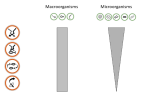Background
Streams are affected by multiple stressors. These stressors often interact in complex ways and impact biodiversity and ecosystem functions. Due to these stressor interactions, predictions about changes in biodiversity and ecosystem function are difficult. Similarly, patterns of ecosystem recovery increasingly receive attention. A mechanistic understanding of degradation and recovery has yet to emerge: to predict stressor effects, their impacts on biodiversity and ecosystem functioning, and to manage the recovery of degraded freshwaters.
What we conceptualise
RESIST is about the mechanisms underlying degradation of and recovery from multiple stressors in streams and rivers. We will test a theoretical framework on the mechanisms causing stressor interactions: the "Asymmetric Response Concept" (ARC). With the ARC, we propose that degradation and recovery are governed by four main processes:
What we aim
RESIST aims to understand how stressors, through mechanisms (Asymmetric Response Concept) affect organisms and functions.

What we hypothesise
Stressor interactions influencing environmental variables and multiple stressor effects on organisms and populations dominate during phases of degradation. Dispersal and biotic interactions dominate during phases of recovery (see Asymmetric Response Concept).

Stressor interactions differ between micro- and macroorganisms (reseach approaches, organism groups):
- Waterquality impacts all organism groups, hydromorphology impacts mainly macroorganisms. Both stressor types have combined effects on environmental variables such as oxygen contents.
- For macroorganisms,the effects of multiple stressors on community stability and function depend on the sensitivity of key species. For microorganisms, functions are highly redundant; thus, effects of multiple stressors on community stability and function are less pronounced than for macroorganisms.
- For macro organisms, multiple stressors mainly affect the interaction of keyspecies (e.g., predation/competition), but modify mainly physiological pathways and gene diversity for microorganisms.
- Dispersal constraints are morelikely to affect macro-than microorganisms, due to smaller population sizes, longer generation times, and the absence of dormant stages.

Functions recover faster than community composition to a pre-degradation stage, due to functional redundancy among taxa. Recovery is correlated to the degree of redundancy, i.e. the relation between taxon diversity and functional diversity. This effect is stronger for micro- than for macroorganisms.


